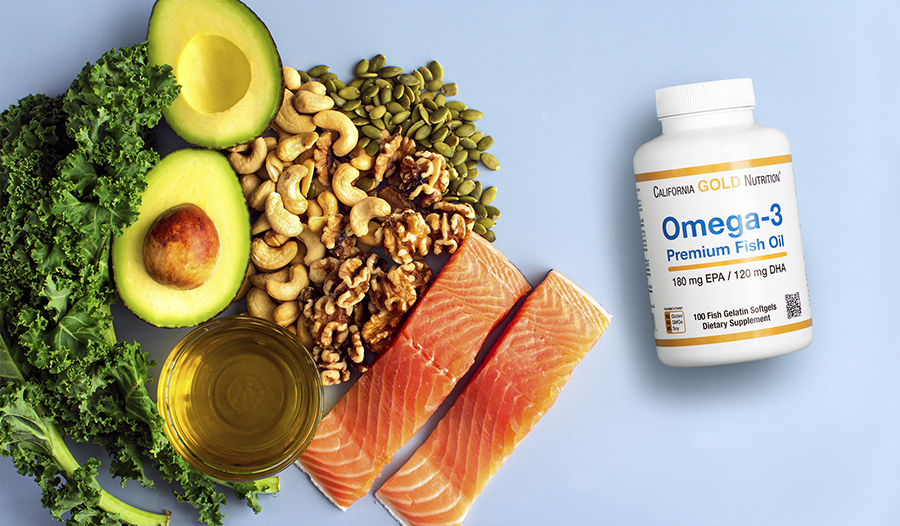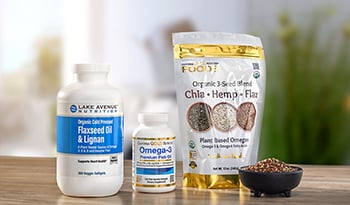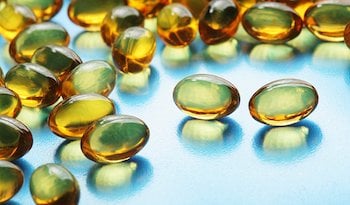Fish Oil Vs. Omega-3: Which Is the Better Supplement Option?
DISCLAIMER:This blog does not intend to provide diagnosis...
- In this article:
- The Difference Between Fish Oil and Omega-3
- Sources of Omega-3s and Their Benefits
- What Forms of Omega-3 Exist?
- What Are Some Health Benefits of Omega-3?
- What to Look for When Choosing an Omega-3 Supplement
- Dosage and Duration
- Safety

You’ve probably heard that omega-3s are great for your health. They play an important role in the makeup of cell membranes throughout the body and support proper cell communication.
Eating fish is an excellent way to get omega-3s into your system. Sometimes, however, it can be hard to include enough fish in your diet to reach your health goals. Taking a supplement can be a good way to ensure you are meeting your body’s needs.
But is it better to take a fish oil or omega-3 supplement? Let’s take a deep dive into the subject and explore the differences between the two, the benefits of each, and what to look for in a high-quality supplement so you can make the right choice.
The Difference Between Fish Oil and Omega-3
Fish oil is an oil produced from the tissues of fish. Omega-3s are fatty acids—specifically, polyunsaturated fatty acids.
Polyunsaturated is a scientific term to describe fatty acids with more than one carbon-to-carbon double bond. Monounsaturated fatty acids, like those found in avocados and olive oil, have only one such double bond. Saturated fatty acids, like those found in butter and coconut oil, have no such double bonds.
Omega-3s come in many different varieties, but there are three types you’ll see most frequently in scientific research—alpha-linolenic acid (ALA), docosahexaenoic acid (DHA), and eicosapentaenoic acid (EPA).
ALA comes from plant sources, like flaxseed, walnuts, and chia seeds. ALA is an essential fatty acid because the body cannot make it. So, it is a fatty acid that you must consume.
EPA and DHA are considered nonessential because the body can synthesize them. Humans have the enzymes to partly convert ALA to EPA and to some extent DHA. However, this conversion rate is low.1,2,3
To achieve optimal levels of EPA and DHA, it’s best to get them from the foods you eat or through a supplement. Fish oil contains both EPA and DHA, making it a useful option for this need.
Sources of Omega-3s and Their Benefits
Fish Oil
Fish oil often comes as a byproduct of the animal feed industry. Herring, sardines, anchovies, mackerel, and menhaden are among the common fish used for this purpose. Their flesh is ground into fishmeal while the oil is used in fish feed, added to pet food, or refined for human supplementation.
Fish Liver Oil
Fish liver oil supplements, such as cod liver oil, contain EPA and DHA in relatively lower concentrations compared to fish oils. However, thanks to their origin in the liver, they are rich in vitamin A and vitamin D. These fat-soluble vitamins are not commonly present in fish oil supplements.
As a bonus, vitamin A is an antioxidant that can guard the omega-3 fatty acids against oxidation. When EPA and DHA oils oxidize, they become rancid, and you may notice a fishy or rotten taste or smell.
Algal Oil
Algal oil offers a source of DHA and EPA that is plant-based. In fact, the DHA and EPA found in fish come from the algae that small fish eat. These omega-3s get transferred up the food chain as larger fish eat the smaller fish. Because algal oil is at the beginning of this food chain, there is less concern about contaminants like mercury, which is a consideration when you consume fish products.
Krill Oil
Krill oil is extracted from Antarctic krill (Euphausia superba). This small shrimp-like animal gets its EPA and DHA content from the algae that it eats. Krill oil also contains the antioxidant astaxanthin. Naturally occurring vitamins A, D, and E add to krill oil’s antioxidant power.
Flaxseed Oil
Flaxseed oil contains ALA. Commonly known as the plant-based omega-3, ALA can also be found in walnuts, soybeans, hemp seeds, canola oil, chia seeds, and, in low quantities, dark leafy green vegetables.
What Forms of Omega-3 Exist?
Omega-3s come in both natural and synthetic forms. The natural forms include triglycerides (TG), phospholipids (PL), and free fatty acids (FFA).
The omega-3s in fish and fish oils exist mainly in TG and FFA forms. Algal oil offers omega-3s, mostly as triglycerides. In krill, a significant amount of omega-3s occur as phospholipids. FFA tends to be avoided in commercial preparations because FFA is very prone to oxidation, so can easily become rancid.
Ethyl ester (EE) is a synthetic form of omega-3.4 When fish is processed to refine its oil for use in supplements, food chemists often choose to convert triglycerides into ethyl esters. This makes it easier to manipulate the concentration of DHA and EPA in the oil.
It’s possible, however, to transform an EE back into a TG. This process is called re-esterification and results in a form of omega-3 called re-esterified or reformed triglyceride (rTG).4
Some manufacturers choose to convert EE’s to rTG’s because some research suggests the body absorbs triglycerides better than ethyl esters.5,6 But there is still a market for omega-3 in EE form because you can improve EE absorption simply by consuming fat-containing food with it.7
What Are Some Health Benefits of Omega-3?
Omega-3s are associated with many potential benefits, from improved heart health, to reduced inflammation, to a lower risk of depression.8 Here’s a deeper look into how you may benefit from consuming more omega-3 fatty acids.
May Help Combat Inflammation
People are most familiar with inflammation as an acute response—it’s how your body fights infection and stimulates the healing process.
After an injury, you may experience pain, warmth, redness, and swelling in the affected area of your body. This acute inflammation results from your immune system sending white blood cells to the injury site.
When inflammation lingers, its chemical signals persist, and the whole process gets prolonged. This is called chronic inflammation. With chronic inflammation, your immune system may mistakenly recognize healthy tissues as a threat and attack them with white blood cells.
Research has linked chronic inflammation to developing conditions like cancer, arthritis, obesity, and heart disease.9
May Help Lower Triglycerides
You’ll see your triglycerides level listed as one of the numbers on a standard cholesterol blood test. Triglycerides are a type of fat that circulates in your blood. When you eat more calories than your body immediately needs, it converts them into triglycerides.
While it’s important to have a normal level of triglycerides, high triglycerides can lead to hardening or thickening of your arteries. This increases your risk of stroke, heart attack, and heart disease.
A review of 41 well-designed studies showed that EPA and DHA given as marine oils reduced triglyceride levels.10 Evidence from randomized controlled trials suggests dietary ALA decreases triglycerides as well.
May Improve Depression Symptoms
A review of 26 well-designed studies concluded omega-3s may have an overall beneficial effect on symptoms of depression.11 The omega-3 formulations that showed this benefit had at least 60% EPA content. The effective dose was at least 1g of EPA per day.
Depression is a serious condition. So, it is wise to consult a health care professional and not rely on supplementation alone to manage symptoms of depression.
What to Look for When Choosing an Omega-3 Supplement
Walk down the supplement aisle of your grocery store, and you may be confronted with an impressive—if not overwhelming—a variety of omega-3 supplements. Here are a few factors to consider when choosing one to get the most effective omega-3 for your needs.
EPA/DHA Content
Reading the label to determine what you are actually getting in a supplement is important. Note what type of omega-3 the supplement contains—EPA, DHA, and/or ALA— and look at the amount of each type. For example, a supplement may have 1000mg of fish oil in each capsule but only 400mg of EPA and 200mg of DHA.
To ensure the claims made on a product label are accurate, check for a Current Good Manufacturing Practices (CGMP) certification. The FDA enforces CGMP regulations, helping you feel assured that the supplement contains what the label states.
The amounts of EPA, DHA and other fatty acid content were analyzed in a study of 47 commercial fish, krill, and algal oil supplements. Only 25% of the tested supplements contained at least the amount of DHA stated on the label. For EPA, only 21% had at least the stated amount.12
Also, find out what form of Omega-3 is in the supplement. Is it TG, rTG, PL, FFA, or EE? While EE may not be absorbed as well as the others, you can improve the absorption by consuming a fat-containing meal with it.7 Some manufacturers include an absorption enhancer in their EE formulations, so there may be no need for such a meal.
Knowing these facts about the product will help you get the most out of your omega-3 supplement—you can’t benefit from it if your body doesn’t absorb it.
Purity
Ensure the supplement meets a certain standard of quality. Contamination is a potential concern for fish oil. Heavy metals, PCBs (polychlorinated biphenyls), and organochlorine pesticides should be kept at an absolute minimum, if not completely eliminated.
Confirm that the supplement has undergone third-party testing. Look for a seal or certification of independent organizations like NSF International, United States Pharmacopeia (USP), Therapeutic Goods Association (TGA), or International Fish Oil Standards (IFOS).
Freshness
As previously mentioned, omega-3s are prone to oxidation and can readily go rancid if not properly handled and stored. Once they spoil, omega-3s may smell foul, lose potency, or even become harmful if consumed.
Check the expiration date, smell the product, and look for any antioxidants in the supplement like vitamins A or E. Heat can speed the spoilage rate. Therefore, generally, it’s wise to store the product in a dry and cool place after opening.
Dosage and Duration
Various health organizations have released their own recommendations on the total omega-3 a person needs daily. The exact amounts differ among the organizations, but the range tends to be between at least 250mg to 500mg of combined EPA and DHA to meet the basic nutritional needs of the general population.13,14,15
Factors like age, diet, genetics, lifestyle, body weight and health condition are important when considering the right dose. It is best to seek the advice of a health professional for guidance in this area, especially if you have a medical condition.
Safety
The side effects of omega-3 supplements, if any occur, are generally mild. Possible adverse reactions include headache, bad breath, unpleasant taste, foul-smelling sweat, and gastrointestinal discomfort.
There is conflicting evidence about whether omega-3s affect the risk of prostate cancer. Some studies have found an increased risk of prostate cancer among men with higher blood levels of omega-3 fatty acids.16 But other research shows that a diet rich in omega-3s can help lower the risk of prostate cancer.17
Since large doses of omega-3 supplements can make your blood less likely to clot, consult your healthcare provider before starting omega-3 supplements if you are on blood thinners or other anticoagulants.
Also, some omega-3 supplements may not be tolerated by individuals allergic to seafood. As with all supplements, it is a good idea to consult your healthcare provider before adding omega-3s to your daily regimen.
References:
- Burdge GC, Jones AE, Wootton SA. Eicosapentaenoic and docosapentaenoic acids are the principal products of α-linolenic acid metabolism in young men. Br J Nutr. 2002;88(4):355-364.
- Burdge GC, Wootton SA. Conversion of α-linolenic acid to eicosapentaenoic, docosapentaenoic and docosahexaenoic acids in young women. Br J Nutr. 2002;88(4):411-420.
- Davis BC, Kris-Etherton PM. Achieving optimal essential fatty acid status in vegetarians: current knowledge and practical implications. Am J Clin Nutr. 2003 Sep;78(3 Suppl):640S-646S.
- Neubronner J, Schuchardt JP, Kressel G, Merkel M, von Schacky C, Hahn A. Enhanced increase of omega-3 index in response to long-term n-3 fatty acid supplementation from triacylglycerides versus ethyl esters. Eur J Clin Nutr. 2011 Feb;65(2):247-54.
- El Boustani S , Colette C , Monnier L , et al. Enteral absorption in man of eicosapentaenoic acid in different chemical forms. Lipids 1987;22:711–4.
- Lawson LD , Hughes BG . Human absorption of fish oil fatty acids as triacylglycerols, free acids, or ethyl esters. Biochem Biophys Res Commun 1988;152:328–35.
- Lawson LD, Hughes BG. Absorption of eicosapentaenoic acid and docosahexaenoic acid from fish oil triacylglycerols or fish oil ethyl esters co-ingested with a high-fat meal. Biochem Biophys Res Commun. 1988 Oct 31;156(2):960-3.
- Baum, S. J. & Scholz, K. P. (2019). Rounding the Corner on Residual Risk: Implications of REDUCE‐IT for Omega‐3 Polyunsaturated Fatty Acids Treatment in Secondary Prevention of Atherosclerotic Cardiovascular Disease. Clinical Cardiology. 2019;42(9):829-838.
- Pahwa R, Goyal A, Jialal I. Chronic Inflammation. [Updated 2021 Sep 28]. In: StatPearls [Internet]. Treasure Island (FL): StatPearls Publishing; 2022 Jan-.
- Agency for Healthcare Research and Quality, Effective Healthcare Program. Omega-3 fatty acids and cardiovascular disease: current state of the evidence. Clinical summary. Rockville, Md.: Agency for Healthcare Research and Quality; July 2017.
- Liao Y, Xie B, Zhang H, He Q, Guo L, Subramanieapillai M, Fan B, Lu C, McIntyre RS. Efficacy of omega-3 PUFAs in depression: A meta-analysis. Transl Psychiatry. 2019 Aug 5;9(1):190.
- Kleiner AC, Cladis DP, Santerre CR. A comparison of actual versus stated label amounts of EPA and DHA in commercial omega-3 dietary supplements in the United States. J Sci Food Agric. 2015 Apr;95(6):1260-7.
- Joint WHO/FAO Expert Consultation on Diet, Nutrition and the Prevention of Chronic Diseases (2002: Geneva, Switzerland) Diet, nutrition and the prevention of chronic diseases: Report of a joint WHO/FAO expert consultation, Geneva, 28 January ‐‐ 1 February 2002. WHO technical report series 916.
- EFSA Panel on Dietetic Products, Nutrition and Allergies (NDA); Scientific Opinion related to the Tolerable Upper Intake Level of eicosapentaenoic acid (EPA), docosahexaenoic acid (DHA) and docosapentaenoic acid (DPA). EFSA Journal 2012; 10( 7):2815.
- U.S. Department of Agriculture and U.S. Department of Health and Human Services. Dietary Guidelines for Americans, 2010.
- Theodore M. Brasky, Amy K. Darke, Xiaoling Song, Catherine M. Tangen, Phyllis J. Goodman, Ian M. Thompson, Frank L. Meyskens, Jr, Gary E. Goodman, Lori M. Minasian, Howard L. Parnes, Eric A. Klein, Alan R. Kristal, Plasma Phospholipid Fatty Acids and Prostate Cancer Risk in the SELECT Trial, JNCI: Journal of the National Cancer Institute, Volume 105, Issue 15, 7 August 2013, Pages 1132–1141.
- Alexander W. Prostate cancer risk and omega-3 Fatty Acid intake from fish oil: a closer look at media messages versus research findings. P T. 2013;38(9):561-564.

 By Dr. Venus Ramos, M.D.
By Dr. Venus Ramos, M.D.


